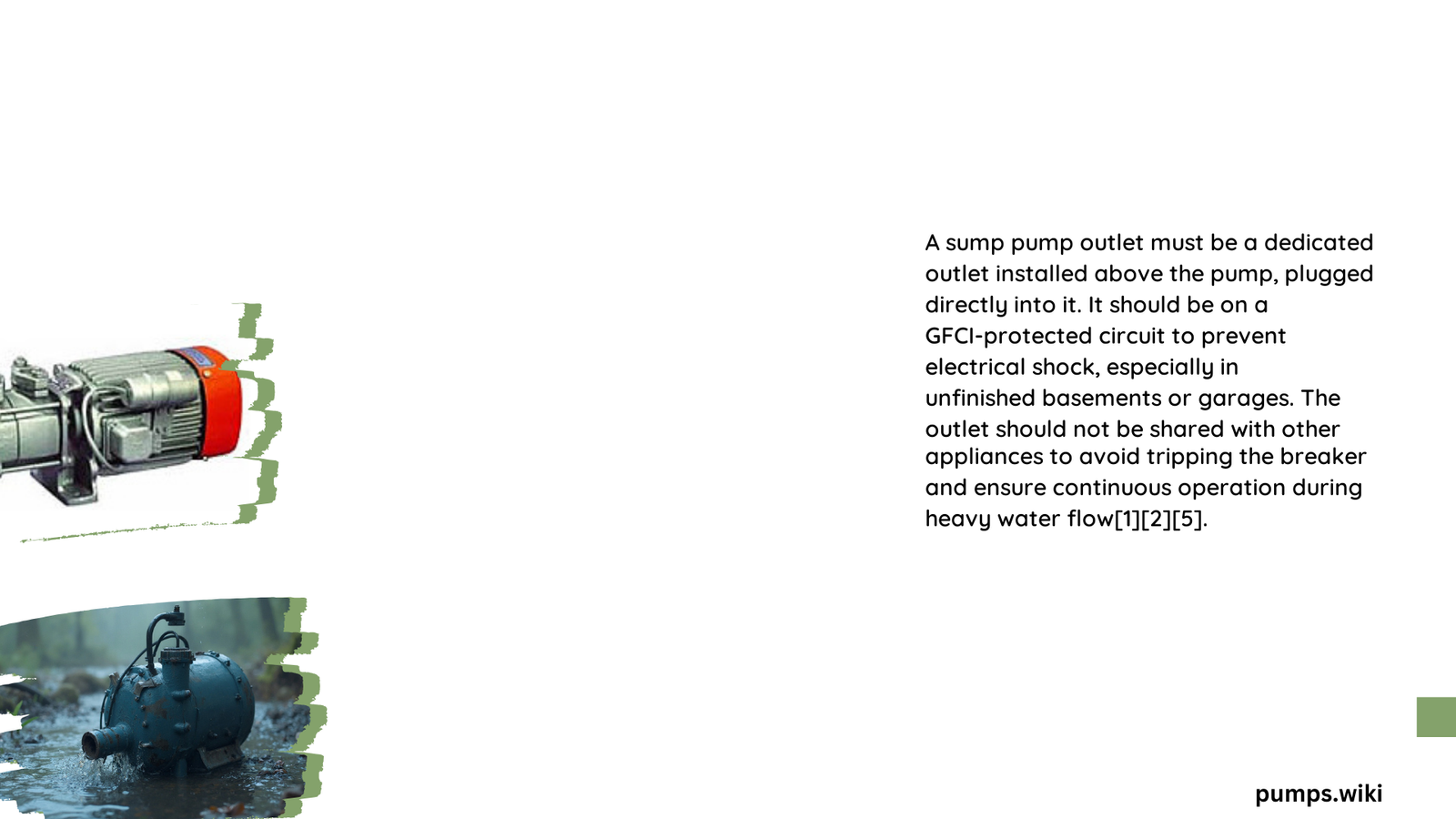Sump pump outlet requirements are crucial for ensuring effective water drainage and preventing basement flooding. These requirements encompass various aspects, including outlet height, discharge pipe size, electrical specifications, and location considerations. Proper installation of sump pump outlets is essential for maintaining a dry basement and protecting your home from water damage.
What Are the Key Sump Pump Outlet Requirements?
Sump pump outlet requirements can be categorized into four main areas:
- Height requirements
- Discharge pipe size
- Electrical specifications
- Location guidelines
Let’s explore each of these in detail.
What Are the Height Requirements for Sump Pump Outlets?

While there are no specific code-mandated minimum or maximum heights for sump pump outlets, practical considerations play a crucial role in determining the appropriate height. The primary goal is to ensure that the outlet is not subject to flooding, which could lead to electrical hazards and pump failure.
Key points to consider for sump pump outlet height:
- Install outlets above the waterline to prevent electrical hazards
- Keep outlets out of flood-prone areas
- For general basement electrical outlets, a common installation height is between 24\” to 55\” above the floor, with 48\” being a standard practice
It’s important to note that while the outlet height itself doesn’t directly affect the pump’s discharge efficiency, proper placement helps prevent electrical issues that could disrupt the pump’s operation.
What Is the Recommended Size for Sump Pump Discharge Pipes?
The size of the discharge pipe is crucial for ensuring adequate water flow and preventing clogs. Here are the recommendations for residential and commercial settings:
Residential Settings:
- Minimum diameter: 1.5 inches
- Recommended diameter: 2 inches
Commercial Settings:
- Minimum diameter: Often 3 inches or more, depending on water volume
The importance of proper pipe diameter cannot be overstated. A larger diameter:
- Reduces the risk of clogs
- Ensures smoother water flow
- Handles higher water volumes more effectively
What Are the Electrical Requirements for Sump Pumps?
Proper electrical setup is crucial for the safe and efficient operation of sump pumps. Here are the key electrical requirements:
- Voltage: 120 volts (standard U.S. household voltage)
- Amperage: Typically 5-10 amps (varies based on pump power rating)
- Circuit: Dedicated single receptacle outlet
- GFCI: Outlet should be exempt from GFCI requirements
Safety Measures:
- Install outlet within 3 feet of the sump pump
- Avoid flood-prone locations for the outlet
- Use a non-GFCI outlet to prevent interruptions during power outages or flooding
Where Should Sump Pump Outlets Be Located?
The location of sump pump outlets is critical for effective drainage and compliance with local regulations. Consider the following guidelines:
- Property Lines: Ensure discharge doesn’t cause water accumulation on neighboring properties
- Elevation: Install above flood levels to prevent electrical hazards and ensure continuous operation
- Drainage Patterns: Avoid interfering with existing drainage systems
- Local Building Codes: Adhere to regulations related to accessibility and flood zones
Special Considerations:
- In flood hazard zones, additional measures like water-powered backup sump pumps may be necessary
- Some areas require outlets to be at least 15 inches above the floor for ADA compliance
What Are the Best Practices for Sump Pump Outlet Installation?
To ensure optimal performance and longevity of your sump pump system, follow these best practices:
- Professional Installation: Consider hiring a licensed plumber or contractor for proper installation
- Regular Maintenance: Inspect and clean the outlet and discharge pipe regularly
- Backup Power: Install a battery backup system for uninterrupted operation during power outages
- Frost Protection: In cold climates, ensure the discharge pipe is protected from freezing
- Landscaping: Direct water away from the foundation and avoid creating puddles near the house
How Often Should Sump Pump Outlets Be Inspected?
Regular inspection of sump pump outlets is crucial for maintaining their effectiveness. Here’s a recommended inspection schedule:
| Frequency | Inspection Tasks |
|---|---|
| Monthly | Check for visible damage or blockages |
| Quarterly | Test pump operation and clean the outlet |
| Annually | Professional inspection and maintenance |
| After Heavy Storms | Inspect for damage and ensure proper functioning |
By adhering to this schedule, you can catch potential issues early and prevent costly water damage to your property.
What Are Common Issues with Sump Pump Outlets?
Understanding common problems can help you maintain your sump pump outlet effectively. Here are some issues to watch out for:
- Clogged discharge pipes
- Frozen discharge lines in winter
- Improperly sized outlets
- Electrical failures
- Incorrect slope in discharge pipes
Addressing these issues promptly can significantly extend the life of your sump pump system and ensure it functions when you need it most.
Conclusion
Proper installation and maintenance of sump pump outlets are essential for protecting your home from water damage. By following these sump pump outlet requirements and best practices, you can ensure your system operates efficiently and effectively, providing peace of mind during heavy rains and potential flooding events.
Remember to consult with local authorities and professional plumbers to ensure your sump pump outlet installation complies with all relevant codes and regulations in your area.
References:
- https://www.sumppumpsdirect.com/stories/80-How-To-Install-A-Primary-Sump-Pump.html
- https://www.electriciantalk.com/threads/basement-outlets.48788/
- https://codelibrary.amlegal.com/codes/richmondhts/latest/richmondhts_oh/0-0-0-27634
